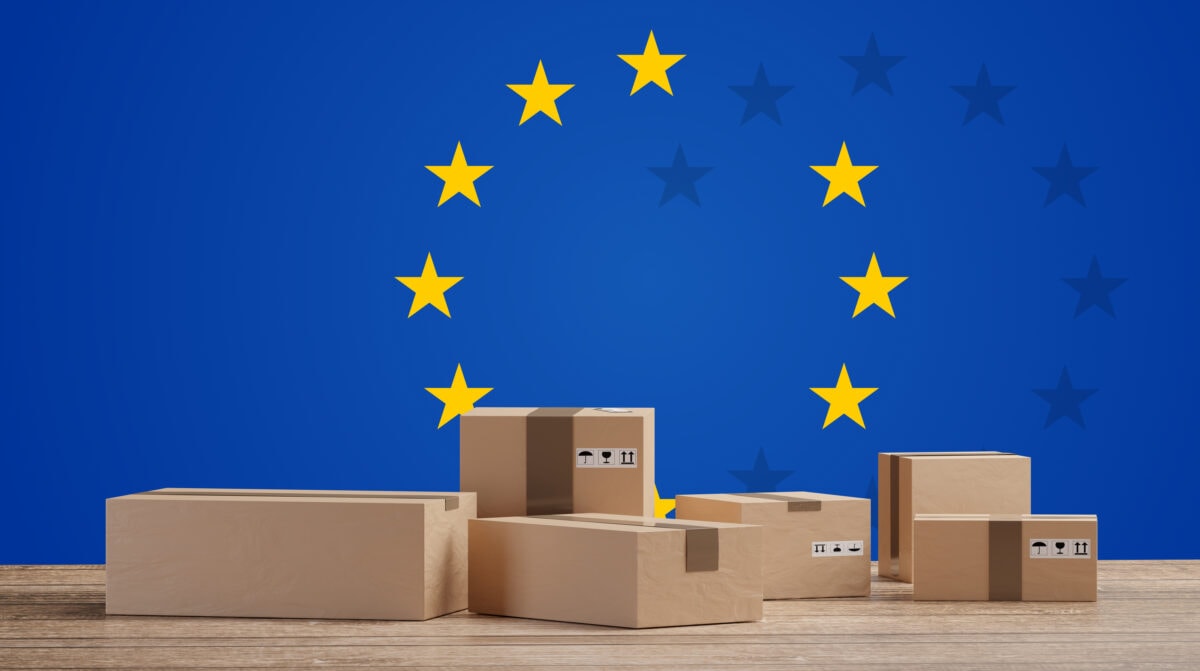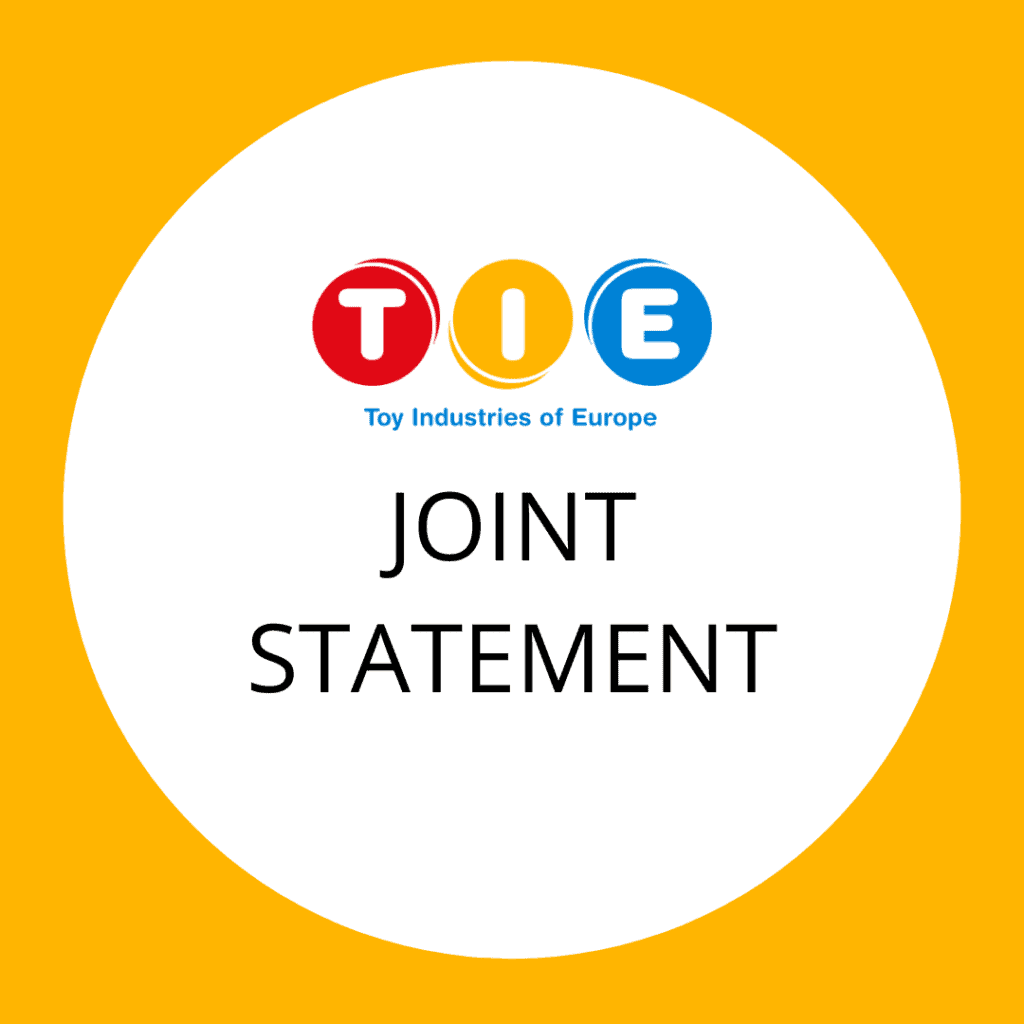Illegal traders are putting children’s safety at risk
- Toys from illegal – often untraceable – traders top EU’s alert system for dangerous products
- Dishonest operators are ignoring the EU’s strict toy safety rules putting children at risk and damaging responsible competition
- 10% of toys notified in 2020 resulted from toy sector’s own investigations into the safety of toys sold by third parties via online marketplaces
- TIE says new EU rules for online marketplaces are a chance to close loopholes that give these illegal traders access to EU consumers
- Vast majority of toys for sale in EU are made by responsible manufacturers and are safe for children to play with
Brussels, 2 March 2021: Illegal toys remained the most flagged product on Safety Gate – the Europe-wide alert system for dangerous goods – last year, representing 26.9% of notifications in total. Toy Industries of Europe (TIE), the EU association for reputable toy makers, underlines that the vast majority of toys sold across the EU are made by responsible firms who respect the EU’s robust toy safety framework and are safe for children to play with.
As in previous years, notifications were overwhelmingly linked to dishonest traders ignoring the EU’s strict toy safety rules. 96.3% were from manufacturers who have no connection to the reputable sector. Two in five of the toys flagged did not even display the manufacturer’s name and address – a basic obligation for toys being sold in the EU to ensure traceability.
10% of toys notified in 2020 were the result of the toy sector’s own investigations into the safety of toys sold by third parties via online marketplaces and represent over one third of notifications linked to the online space in the report. TIE’s mystery shopping investigation found 97% of toys bought were non-compliant. Combined with the rapid growth of e-commerce during the pandemic, the Safety Gate figures are undoubtedly the tip of the iceberg when it comes to the availability of unsafe toys online from third party sellers.
Catherine Van Reeth, Director General of Toy Industries of Europe said that: “TIE members are reputable companies who prioritise toy safety to make sure children have the best playtime possible. However, EU children are being put at risk by illegal traders selling dangerous toys via online marketplaces. Current rules mean third parties selling on marketplaces can bypass real-world checks and balances, combined with the huge volume of sales via marketplaces, market surveillance is rendered almost impossible. Preventive action is needed to stop illegal toys from being listed at all. The Digital Services Act, currently being discussed in the European Parliament and Council, can provide effective solutions and we are calling on them to address this.”
###
If you would like more information on this topic please contact jennifer.pearson@toyindustries.eu
Notes to editors follow below.
Notes to Editors
What is the EU Safety Gate?
The EU Safety Gate has been working to stop unsafe products – including toys – from reaching consumers since 2004. It does this by making sure that if a product that puts consumer health and safety at risk is seized by authorities in one country, the other 30 countries in the system are automatically alerted and can easily take action to stop it from being sold in their market or recall when needed.
On the figures
A total of 601 alerts for toys were submitted on the Safety Gate in 2020. Toys were followed by motor vehicles (21.7%), electrical equipment (10.2%), Protective Equipment and Clothing (7.8%), Textiles and Fashion Items (6.5%). 96.3% of the alerts for toys related to manufactures with no connection to any European toy associations, this is important as one way for reputable companies to demonstrate their responsibility to safety is to become part of toy associations like TIE and its national association members. This gives companies who want to do the right thing access to expert advice and training and helps to raise standards across the board.
Should parents be worried about the toys their child plays with?
Playing is an important part of growing up. It has positive benefits on children’s development, health and well-being and shapes them into the adults they later become. Toys have been a central part of playing for generations – studies show that toys can encourage children to play longer and explore new ways to play.
Toys from reputable manufacturers are designed to give children the safest, most appropriate and fun play experiences possible. They invest time and money in product design and testing, the make sure products are easily identifiable and have process in place to quickly any address any issues that occur.
Why do toys appear so often in reports about dangerous products?
The toys at the centre of official statistics on unsafe products in the EU tend to originate from illegal operators. These figures do not represent the toys available to buy in the EU overall, and their appearance demonstrates good market surveillance in action.
However, this isn’t the full picture. It’s also important to remember that the EU toy sector operates in one of the strictest product safety frameworks in the world. The Toy Safety Directive is at the heart of this framework, and toy safety standards help to fill in the criteria for what a safe toy should look like.
To put the toy safety framework into context – a doll’s fork has to meet stricter requirements than the real fork a child uses to eat its dinner with, and the textiles the doll’s clothes are made of have stricter chemical controls than the clothes the child wears.
This framework means that toys have to stand up to tougher rules than the many other products children come into contact with every day. Living up to these high-standards can be costly for manufacturers, unfortunately this means that a few dishonest traders choose to ignore the rules and cut corners for profit.
As well as being one of the most regulated product categories, toys are also one of the most highly scrutinised. On top of living up to tougher rules than other products, toys are also subject to more frequent controls by authorities. Rightly so given they are intended for children to play with.
The stricter rules and more frequent inspections mean that toys appear more often in market surveillance statistics than other products. However, their inclusion in these figures does not mean that toys are unsafe for children to play with: if all consumer products enjoyed the same level of scrutiny, we would see a comparable number of notifications for other categories.
The recent report shows that 31.5% of toys were notified due to chemical dangers, namely the presence of phthalates. What is your reaction to this?
All toys, put on the EU market by reputable manufacturers go through stringent testing procedures to make sure they meet all relevant safety standards. This includes tests for the chemicals they contain. EU testing limits have been decided on the basis of sound scientific agreement and have buffers built in that already add an extra level of precaution.
However, although toys are one of the most strictly regulated consumer goods in Europe, this does not stop dishonest companies from putting substandard products on the market. Phthalates have been banned for over twenty years for example. This is why loopholes allowing sellers outside the EU direct access to EU consumers via online marketplaces need to be closed up.
The majority of notified toys were manufactured in China. Are these toys dangerous?
The fact that the majority of all notified toys originate in China is not a reason for concern. China is an important toy exporting country and produces around 83% of toys on the European market. It is therefore to be expected that the majority of toys inspected by authorities come from China, which increases the likelihood that any notified toys may have been produced in China. It is important to remember that all toys placed on the EU market, regardless of where they are manufactured, must meet the same strict European toy safety requirements.
How can the EU help make sure that toys sold in the region are safe?
One of the biggest areas of sales growth this year has been e-commerce. This is fantastic as it provides new audiences for toy companies and more choice for consumers. However, it also opens new doors for dishonest traders to sell on the EU market. As well as increasing resources for market surveillance and customs authorities its essential that the EU’s e-commerce rules don’t give illegal operators free access to EU consumers.
About Toy Industries of Europe
Toy Industries of Europe (TIE) is the voice of the reputable European toy industry. TIE’s membership includes 18 direct international companies, eight European national toy associations, who represent their local manufactures, and eight affiliate members who make toys but it’s not part of their main business.
Click here for an executive summary of “EU Toy Safety: the problem of unreputable sellers on online marketplaces”


